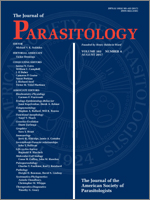Salmincola californiensis infected 25 of 31 (prevalence 0.8; intensity 2–35 [mean 6.6 ± standard deviation 7.7; n = 25]) rainbow trout, Oncorhynchus mykiss, from a private trout farm connected to the Watauga River, North Carolina. Salmincola edwardsii infected all of 9 (1.0; 2–43 [9.3 ± 13.0; 9]) brook trout, Salvelinus fontinalis, from Big Norton Prong, a tributary of the Little Tennessee River, North Carolina. Both lernaeopodids are well-known salmonid pathogens, but neither is native to, nor has been previously taxonomically confirmed from, the southeastern United States. Herein, we (1) use light and scanning electron microscopy to identify and provide supplemental morphological observations of these lernaeopodids, (2) furnish complementary molecular sequence data from the 28S rDNA (28S), and (3) document the pathological effects of gill infections. We identified and differentiated these lernaeopodids by the second antenna (exopod tip with large [S. californiensis] vs. slender [S. edwardsii] spines; endopod terminal segment with subequal ventral processes shorter than [S. californiensis] vs. longer than or equal to [S. edwardsii] dorsal hook), maxilliped palp (length typically ≤1/3 [S. californiensis] vs. 1/3–1/2 [S. edwardsii] subchela length exclusive of claw), and bulla (sub-circular and concave on manubrium's side [S. californiensis] vs. non-stellate [S. edwardsii]). Analysis of the 28S rDNA sequences confirmed our taxonomic assignments as demonstrated by 100% sequence similarity among the sympatric, morphologically-conspecific isolates. Histopathology revealed focal gill epithelial hyperplasia, obstruction of interlamellar water channels, lamellar fusion, and crypting of gill filaments. High intensity infections by either lernaeopodid are surveillance-worthy because they are potentially pathogenic to trout in the southeastern United States.
BioOne.org will be down briefly for maintenance on 12 February 2025 between 18:00-21:00 Pacific Time US. We apologize for any inconvenience.
How to translate text using browser tools
1 August 2017
Exotic “Gill Lice” Species (Copepoda: Lernaeopodidae: Salmincola SPP.) Infect Rainbow Trout (Oncorhynchus mykiss) and Brook Trout (Salvelinus fontinalis) in the Southeastern United States
Carlos F. Ruiz,
Jacob M. Rash,
Doug A. Besler,
Jackson R. Roberts,
Micah B. Warren,
Cova R. Arias,
Stephen A. Bullard
ACCESS THE FULL ARTICLE

Journal of Parasitology
Vol. 103 • No. 4
August 2017
Vol. 103 • No. 4
August 2017




